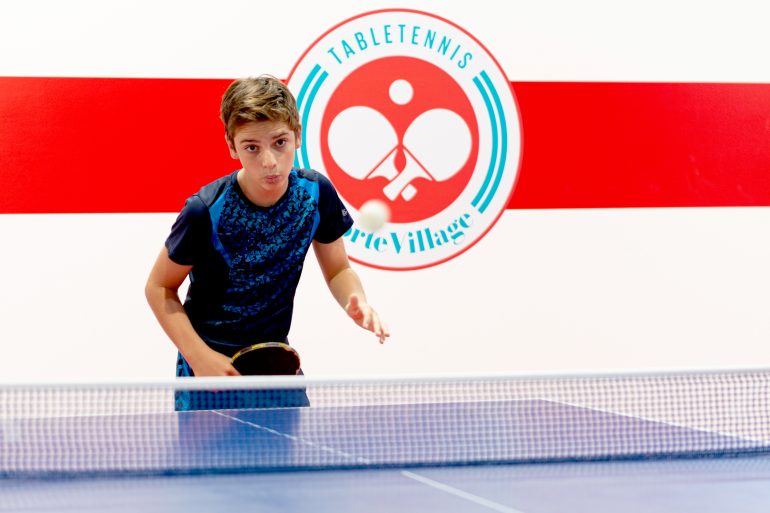Table tennis: history and characteristics of a sport for everyone
Table tennis: origins and evolutions of table tennis
Table tennis, popularly known as ping pong, is one of the most popular sports in the world and is suitable for all ages, it has also been an Olympic speciality since 1988 and can be played in restricted areas, both indoors and outdoors, but equipped and spacious indoor areas are required for competitive practice.
Table tennis, just like tennis, comes from the ancient French game Jeu de Paume and was played in England in 1880 as a pastime of high society.
In the United Kingdom ruled by Queen Victoria, the impossibility of playing tennis during the winter period due to the lack of indoor facilities contributed to the birth and popularity of “home tennis” that was played after dinner in the famous London high society clubs with improvised materials and equipment: champagne caps instead of balls, cigar boxes used as rackets and books to simulate a net.
The first ping pong set, quite similar to modern table tennis, was built in 1890 by David Foster who gave it the name of Parlour Table Games and placed inside the package a large green cloth to be laid on a table with painted lines like those of a tennis court, two mini racquets, a 30 mm rubber ball covered with cloth, a wooden fence to be placed on the table to define the playing area, a 10 cm high net to be placed in the middle of the table, and two large nets to be placed on the sides to prevent the ball from leaving the area during the game.
Only a year later, Jacques of London, a famous gaming company, launched the Gossima Game, which included two new drum-like rackets, a cloth-covered cork ball with a 50 mm circumference, and a 30 cm high net.
Despite Victorian society’s interest in tennis, the two games were soon shelved because the David Foster kit contained rubber balls that had an unpredictable and uncontrollable bounce, while the cork ones did not bounce enough and made the game less fluid.
In the early years of the twentieth century, thanks to the advent of plastic and celluloid, the balls changed appearance and John Jacques, owner of the Jacques of London, renewed the Gossima Game and launched it on the market under the name of Ping Pong, an onomatopoeic term that refers to the noise that the ball makes when it bounces on the table.
The game became popular worldwide in a short time, and in 1926 the very the first International Table Tennis Federation was founded. In January of that same year, the first international tournament was held in Germany, followed by the first World Championship hosted in London, with athletes from Austria, Czechoslovakia, Denmark, Germany, Sweden, India and Hungary.
The latter won almost all the medals, imposing itself on the tennis player scene until the outbreak of World War II.

Table tennis: the Asian school
The diffusion of table tennis in Asia first affected China in the late 19th century and then Japan and Korea. It is in the largest continent of the world that the pen style was invented, which refers to how one grips the racket that recalls the position of fingers while writing.
Also in Asia, in 1951, the so-called sandwich covers were introduced, changing the structure of the rackets which until then were made out of wood and covered with a layer of speckled foam.
The novelty represented by the sandwich covers was the insertion of a layer of foam rubber between the wood and the rubber canvas, making the shots faster and more effective. A revolution at the time, increasing the popularity of ping pong and the number of practitioners at all levels.
During those years, Mao Tse Tung made table tennis the national sport and shortly after, the People’s Republic of China won the title of the strongest nation in ping pong by claiming, until now, 24 Olympic gold medals out of 28.
In the 1970s, encounters between Chinese and American athletes, the only Americans to be allowed to enter Chinese territory after the establishment of the Mao regime, helped improve Sino-American relations. The event that marked the political thaw between the two superpowers went down in history under the name of “ping pong diplomacy”.
Today, with forty million players estimated at a competitive level and more than three hundred million amateur players, mostly Chinese, ping pong is the most played sport in the world.

Table tennis: features and rules of the game
Table tennis can be played one on one or in couples, and the winner is the first player to win the set, that is the player who reaches the first 11 points. If during the game the players both reach 10 points, the winner will be the first to win 2 points over the opponent.
The playing area of international competitions measures 12 meters in length, 6 meters in width and 4 meters in height, while in national, interregional and regional competitions, the measures are 10 x 5 x 4 meters. In regional games, 8.5 x 4.25 meters are also tolerated.
At the start of the match, a draw is made between the players and the winner is entitled to choose the side of the table he or she prefers or whether to serve or receive first.
He who begins makes two consecutive serves, after which the ball passes to the opponent. The sequence of the two serves alternates until the end of the game except when a tie is made at 10 points, where the sequence of the serves is limited to a single throw per person.
The game begins when the ball leaves the hand of the player who performs the service. The service must comply with precise rules:
- the server must have the ball on the open palm of the free hand and motionless to be visible to the opponent;
- the ball must be throw upwards with a maximum angle of 30° without any effect so that it rises at least 16,5 cm and falls back without touching anything before being hit.
- the ball must be hit over and above the bottom line of the table, it must bounce once in its field and, after passing over the net, it must fall back into the opposing field. If the ball touches the net, supports included, before it touches the opposing field a foul is committed without penalty and the serve must be repeated;
- if the player does not hit the ball after throwing it, the point is assigned to the opponent;
- if before the service the opponent raises his hand for reasons of force majeure and does not touch the ball by making it fall on the floor, the thrower must perform a new service without penalties for the opponent.
- Whenever a rule of service is not respected, the batter makes a foul, and the referee assigns a point to the opponent. A player also commits a foul in the following cases:
- when he touches the table with his free hand
- when moving the game table
- when speaking during the exchange
- the player, or his racket, touches the net
The point is assigned when:
- the opponent performs a wrong service or fails to perform it after he has put the ball into play
- opponent misses the ball or gets it wrong
- the opponent commits one of the following fouls:
- the ball bounces two or more times in their field
- the opponent strikes without having let the ball bounce once in their field
- the opponent hits or touches the ball with something different than the racquet or the hand with which it is held
- the opponent deliberately hits the ball twice in a row.

Table tennis: Table Tennis Academy at Forte Village
Do you want to discover all the secrets of table tennis and become a ping pong champion? Forte Village, an award-winning resort surrounded by the beautiful Sardinian sea, dedicates one of its sports Academies to table tennis: the Table Tennis Academy.
Lessons are held in the gym of the Sports Academy Center, equipped with four professional tables, and you can choose between group lessons for children and teenagers, individual lessons for players of all ages and fun weekly tournaments.
The group academy is structured over five days, from Monday to Friday and all participants receive the Forte Village Table Tennis Academy kit which includes: a backpack, a training shirt, a professional racquet with racket holder and a set of ping pong balls.
Table tennis is just one of the many sporting activities that make up the wide range of activities at Forte Village: from football to go-karting, water sports to rugby and the ancient art of fencing, there is really something for everyone!
Want to learn the tricks of table tennis and have a dream holiday in a true paradise? Discover Forte Village Resort.






